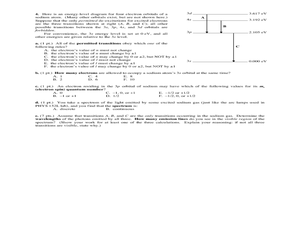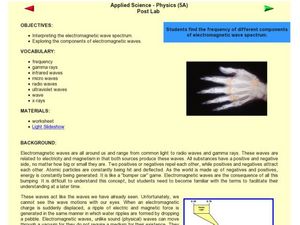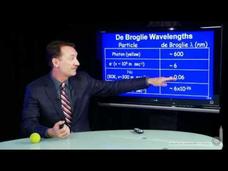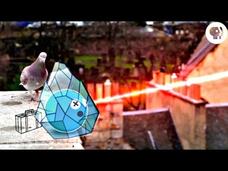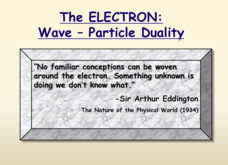Wave-particle Duality Teacher Resources
Hi, What do you want to do?
Find Wave-particle Duality lesson plans and worksheets
Showing 253 resources
Crash Course
Quantum Mechanics—Part 1: Crash Course Physics #43
How can light be both a particle and a wave? With characteristics of each, the idea of light can be confusing. A lesson in the Crash Course physics series introduces scholars to quantum mechanics and how scientists use it to understand...
Alabama Learning Exchange
Mirror, Mirror on the Wall: Reflections of Light
Why can we see our reflection in a window but not a brick wall? Young physicists learn the Law of Reflection and various light properties that help them answer this and other questions about reflection. Use the PowerPoint to introduce...
MinutePhysics
The Speed of Light in Glass
What happens to the speed of light as it goes through a glass door? Light travels slower through glass than through air, but does the speed of light change or is it just our perception? The short video explains the speed of light as it...
Curated OER
Wave Math
Students identify the different factors affecting the size and shape of ocean waves. In this math lesson, students calculate wave speed and wavelength given a mathematical formula.
Veritasium
The Original Double Slit Experiment
Is light a wave or a particle? The video recreates the double slit experiment with sunlight in public. Different individuals predict what they will see by looking into a dark box, which allows sunlight into it through two small slits....
TED-Ed
Einstein's Miracle Year
Why was Albert Einstein initially labeled as a "failed" academic, and what events occurred in 1905 that constituted a major turning point for this great scientist? Review Einstein's major theories regarding relativity, light...
Curated OER
Physics 152 Fall 2004 Final Exam, Parts A, B, C, D
At the end of a general physics course focused on light and electricity, you can administer this exam. Concepts covered include electromagnetism, circuits, induction, light rays, lenses and mirrors, characteristics of light, electron...
Curated OER
Properties of Waves
Third graders observe and investigate wave properties and compare the properties of particles and waves. They fill a pie pan half full with water, place a toothpick in the center of the pie pan, then drop a marble into the pan and...
Curated OER
Electromagnetic Wave Spectrum
Fifth graders examine electromagnetic wave spectrum. In this science lesson, 5th graders discuss the aspects of the electromagnetic wave spectrum and complete a worksheet identifying the parts of the spectrum.
Curated OER
What Are Waves?
In this types of waves worksheet, students will read 9 types of waves and classify them as either mechanical, electromagnetic, transverse, or compressional waves. Then students will label two wave diagrams with the 8 kinds of waves...
MinutePhysics
What Is the Uncertainty Principle?
Are you unsure about the uncertainty principle? Using drawings and verbal explanations, this video explains why we cannot know everything about a particle. This is an ideal one-minute addition to your presentation on wave behavior.
National Institute of Open Schooling
Atomic Structure
Learners explain historical findings such as Rutherford and Bohr's contributions, explain wave particle duality, and formulate Heinsenberg's uncertainty principle. They also draw s, p, and d orbitals, explain more historical findings,...
Berkeley University of California
De Broglie Wavelengths
You learned in the previous lesson in this series that a particle with momentum has the properties of a wave. So how about a baseball? The lesson calculates the wavelengths of different particles given their momentum (mass and velocity),...
Physics Girl
Seeing the Smallest Thing in the Universe
How do we see what we can't see? An episode of a comprehensive physics playlist shows images of the smallest particles current technology can record. The instructor discusses current and past research on the makeup of subatomic particles.
Veritasium
Is This What Quantum Mechanics Looks Like?
How can oil and a speaker help us understand quantum mechanics? An episode of the Veritasium playlist demonstrates the movement of silicone oil droplets on a speaker. The wave motion of the particles seems to mimic the behavior and...
Physics Girl
How Does Laser Cooling Work?
We typically think of lasers adding heat energy, but lasers can be used for cooling, too! An episode of a physics playlist discusses the science of lasers. Learners watch how to place lasers to effectively slow subatomic particles.
Curated OER
The Energy of Waves
For this science worksheet, learners examine the topic in order to solidify knowledge covered in the curriculum using puzzles and creative games.
Curated OER
Making Waves, Making Music, Making Noise
Young scholars construct "talking cans" and instruments to explain how vibration of objects produces various sounds.
Science Geek
The Dual Nature of the Electron
Why don't atoms collapse? Scientists debated this concept for years before they understood the dual nature of the electron. Presentation discusses the electron as both a particle and an energy wave. It also relates these concepts to the...
Colorado State University
What's the Difference Between Blue Light and Red Light?
Finally, an electromagnetic spectrum lab that will get glowing reviews from your class! Explore the nature of light using red and blue LED sources and fantastic phosphorescent paper. Young scientists compare the effects of blue light...
Curated OER
The Photoelectric Effect in Photocells
Illuminate your physics class with this examination of a photovoltaic cell. Teach the structure and operation of the device using a diagram. Then make a human-powered, larger-than-life sized model of a PV cell. Learners become electrons...
Curated OER
Waves Velocity & Particle Velocity
In this physics worksheet, students examine a single wave pulse which travels down a slinky. Then they sketch a single ring of the slinky as the wave goes by and determine whether the wave is constant or not.
Curated OER
Light
In this light worksheet, students match 12 terms related to light and the electromagnetic spectrum to their definitions, they order waves by their speed, they analyze the energy and wavelengths of the electromagnetic spectrum and they...
Curated OER
Sound
Students identify and explain these vocabulary words: vibration, volume, pitch, particles, tuning forks, waves and matter. They explain that sound travels through gas, liquid and solid. They be






